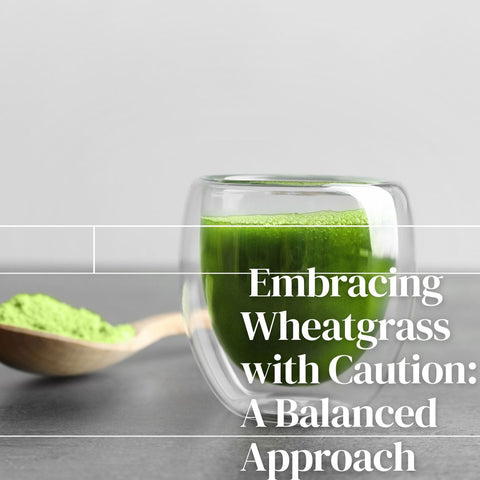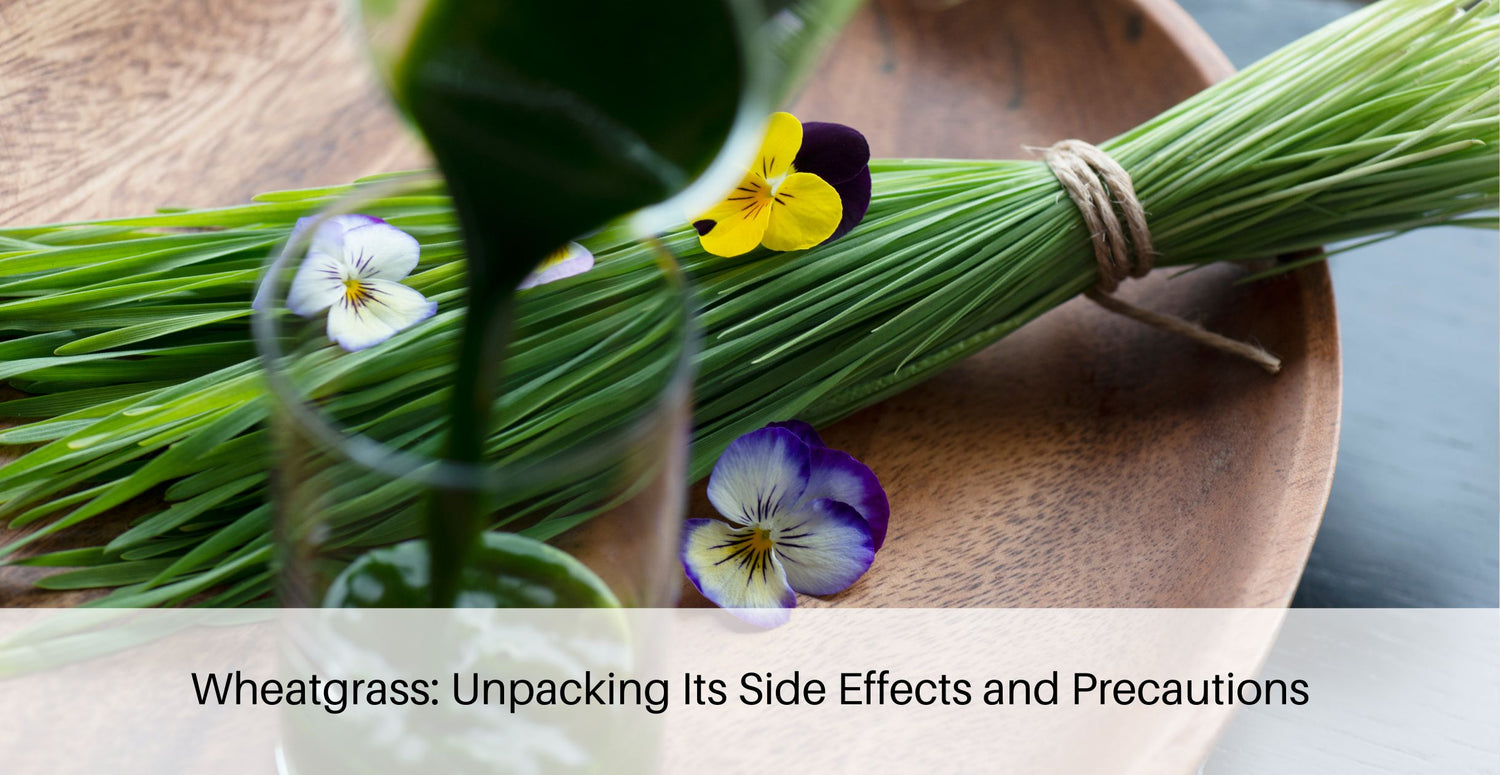Wheatgrass has become popular as a health supplement due to its high nutrient content, which includes vitamins, minerals, enzymes, and chlorophyll. While many people consume wheatgrass without incident, it is critical to be aware of the potential side effects and precautions associated with its consumption.
Exploring Wheatgrass: Benefits That Shadow the Risks

While it is important to be aware of potential side effects and precautions, wheatgrass also has several potential health benefits that frequently outweigh the risks for many people. Wheatgrass consumption has several benefits, including nutrient-richness, antioxidant properties, immune support, anti-inflammatory effects, digestive health, energy and vitality, alkalizing effects, and skin health.
Wheatgrass 101: A Nutrient Powerhouse
Wheatgrass is often referred to as a nutrient powerhouse because of its high concentration of vitamins, minerals, antioxidants, and other beneficial compounds. This blog takes a closer look at why wheatgrass is considered such a nutritional powerhouse, including vitamins, minerals, chlorophyll, antioxidants, enzymes, amino acids, dietary fibre, and alkalinity.
The Dark Side: Recognizing the Side Effects of Wheatgrass
Including seitan in your diet is an important step towards developing diverse and healthy eating habits. Incorporating seitan into your diet is a tasty and nutritious way to change up your meals and adopt a healthier eating style. Whether you want to increase your protein intake, try new recipes, or make more sustainable food choices, seitan is a tasty and versatile option that can improve your overall health and well-being.
Navigating the Side Effects: What Potential Risks to Expect

While seitan is a nutritious and versatile plant-based protein option for many people, it may not be appropriate for everyone, especially those with gluten sensitivities, wheat allergies, or specific dietary restrictions. If you are concerned about consuming seitan or have adverse reactions after eating it, you should consult with a healthcare professional. Furthermore, selecting high-quality, organic, and minimally processed seitan products can help to reduce potential risks and ensure a safe and enjoyable culinary experience.
Digestive Distress: Wheatgrass and Your Gut Health
Wheatgrass is a nutrient-dense superfood made from the young shoots of wheat plants. While wheatgrass is generally considered safe to consume and contains numerous health benefits such as vitamins, minerals, antioxidants, and chlorophyll, some people may experience digestive distress or intolerance when eating it. Here's how wheatgrass affects gut health and what to consider:
-
Wheatgrass contains gluten, a protein found in wheat, barley, and rye that can cause reactions in people with gluten sensitivity or celiac disease. Although wheatgrass contains little gluten and may be tolerated by some gluten-sensitive individuals, others may experience digestive symptoms such as bloating, gas, abdominal pain, diarrhoea, or fatigue after consuming wheatgrass. Individuals with gluten-related disorders should exercise caution when consuming wheatgrass and choose gluten-free alternatives to avoid negative reactions.
-
Wheatgrass is high in dietary fibre, which can help with digestive health by promoting regular bowel movements, preventing constipation, and encouraging the growth of beneficial gut bacteria. However, consuming large amounts of wheatgrass or suddenly increasing fibre intake can cause digestive discomfort, such as bloating, gas, or cramping, particularly in people with sensitive digestive systems. To avoid potential digestive issues, gradually incorporate wheatgrass into your diet and drink plenty of water.
-
Wheatgrass is typically grown and harvested in controlled environments to reduce contamination, but some wheatgrass products may contain microbial contamination, pesticides, or heavy metals. Wheatgrass contaminants have the potential to harm gut health and cause digestive issues in sensitive individuals. Choosing high-quality, organic wheatgrass products from reputable sources can help reduce contamination and ensure food safety.
-
Individual tolerance for wheatgrass, like that of any other food or dietary supplement, varies. While wheatgrass may provide digestive benefits and improve gut health for some people, others may be more sensitive and have negative reactions. It's critical to listen to your body and understand how wheatgrass affects digestion. If you experience digestive distress or discomfort after consuming wheatgrass, consider reducing your intake or discontinuing use, and consult with a healthcare professional as needed.
Allergies and Intolerances: Identifying Your Risk
Understanding the difference between allergies and intolerances, as well as recognising common symptoms associated with each, is necessary for determining your risk of developing them. Here's how to distinguish between allergies and intolerances and determine your risk:
Allergies:-
Allergies are caused by the immune system's reaction to specific proteins found in food or other substances. When the immune system misidentifies a harmless substance (allergen) as a threat, it causes an allergic reaction.
-
Allergic reactions can range in severity and may include skin reactions (hives, itching, eczema). Respiratory symptoms (wheezing, coughing, nasal congestion), gastrointestinal symptoms (nausea, vomiting, diarrhoea), and anaphylaxis (a severe, life-threatening reaction characterised by difficulty breathing, throat swelling, and a drop in blood pressure).
-
Common allergens include peanuts, tree nuts, milk, eggs, soy, wheat, fish, and shellfish.
-
Allergies are typically diagnosed through skin prick tests, blood tests (such as IgE antibody tests), and oral food challenges conducted by allergists or immunologists.
Intolerances:
-
Intolerances involve difficulty digesting certain foods or substances due to enzyme deficiencies or sensitivities. Unlike allergies, intolerances do not affect the immune system and are not life-threatening.
-
Food intolerance symptoms can vary and may include digestive discomfort (bloating, gas, abdominal pain). Diarrhea or constipation, Headaches or migraines, Skin issues (eczema, rashes) and Fatigue or brain fog
-
Common food intolerances include lactose intolerance (difficulty digesting lactose, the sugar found in milk), gluten intolerance (celiac disease or non-celiac gluten sensitivity), and histamine intolerance.
-
Food intolerances are typically diagnosed through elimination diets, where specific foods are eliminated from the diet for some time and then gradually reintroduced to assess symptoms. Breath tests, blood tests, and stool tests may also be used to diagnose certain intolerances.
Assessing Your Risk:
-
People with a family history of allergies or intolerances may be more likely to develop similar conditions.
-
If you have previously had negative reactions to certain foods, such as immediate or delayed symptoms after consumption, you may be allergic or intolerance-prone.
-
Certain health conditions, such as autoimmune disorders or gastrointestinal disorders, may increase the risk of developing food allergies or intolerances.
-
If you suspect you have food allergies or intolerances, or if you experience symptoms after eating certain foods, see a doctor for an accurate evaluation, diagnosis, and treatment.
You can more accurately determine your risk and take the necessary action to manage your dietary requirements and general health by being aware of the distinctions between allergies and intolerances, as well as common symptoms.
The Gluten Debate: Is Wheatgrass Safe for Celiacs?
Wheatgrass's safety for people with celiac disease is uncertain, and experts' opinions differ. While wheatgrass is generally believed to have a low gluten content, some people with celiac disease may be able to tolerate it, while others may experience adverse effects. Individuals with celiac disease should consult with a healthcare provider or registered dietitian before incorporating wheatgrass into their diet, taking into account their tolerance levels, potential risks, and preferences. To reduce the risk of gluten contamination, prioritise gluten-free products that are labelled as such and processed in a gluten-free facility.
Wheatgrass Dosage and Safety: Finding the Right Balance

Finding the right wheatgrass dosage involves taking into account individual tolerance, potential risks, and desired health benefits. Begin with a low dose, monitor your body's response, and adjust your dosage accordingly. Consult a healthcare provider or registered dietitian to receive personalised recommendations based on your specific needs and health status. By following these guidelines and prioritising safety, you can reap the potential health benefits of wheatgrass while reducing risks.
Dosage Guidelines: How Much Is Too Much?
The amount of wheatgrass that is deemed excessive depends on some variables, such as dietary preference, general health, and individual tolerance. Here are some general dosage guidelines that will help you consume wheatgrass safely:
-
Fresh Wheatgrass Juice: If you want to drink fresh wheatgrass juice, start small—1-2 ounces (30–60 millilitres) per day, for example—and work your way up to determine your tolerance. It is important to pay attention to your body's reaction, even though some people may be able to handle higher dosages.
-
Wheatgrass Powder or Tablets: Follow the recommended serving size listed on the product packaging. Typical daily doses range between 1-3 grammes of wheatgrass powder and 1-2 tablets. Unless advised by a healthcare professional, do not exceed the recommended dose.
-
Frequency of Consumption: Consistency is essential when consuming wheatgrass. Aim for daily consumption to maximise the potential health benefits. However, if you experience any side effects, consider reducing the frequency or dosage until the symptoms resolve.
-
Individual Tolerance: Individual tolerance for wheatgrass can vary greatly. Some people can tolerate higher doses without experiencing side effects, whereas others may be more sensitive and require lower doses. Pay attention to how your body reacts, and adjust your dosage accordingly.
-
Health Status: The dosage of wheatgrass should be determined by taking into account your overall health as well as any underlying medical conditions. People who suffer from autoimmune diseases, digestive problems, or allergies should be cautious or stay away from wheatgrass completely.
-
Potential Risks: Recognise the possible risks of consuming wheatgrass, such as interactions with medications, allergies, or gluten sensitivity. Before including wheatgrass in your diet, speak with a healthcare provider if you have celiac disease or gluten sensitivity.
-
Quality and Purity: Choose high-quality wheatgrass products from reputable sources to ensure purity and safety. Look for products that are organic, non-GMO, and free from contaminants such as pesticides, heavy metals, and microbial pathogens.
-
Moderation: As with any dietary supplement, moderation is key. Avoid excessive consumption of wheatgrass, as it may lead to digestive discomfort or other adverse effects. Stick to recommended dosages and listen to your body's signals.
Special Populations: Wheatgrass Use in Pregnancy and Illness
The use of wheatgrass during pregnancy and illness must be carefully considered due to potential risks and individual health needs. Here's what to consider for each unique population:
Wheatgrass Use in Pregnancy:
-
There is limited research on the safety of wheatgrass consumption during pregnancy. While wheatgrass is generally considered safe for most people, pregnant women should exercise caution due to the lack of conclusive evidence regarding its safety during pregnancy.
-
Wheatgrass is rich in vitamins, minerals, antioxidants, and chlorophyll, which can provide valuable nutrients during pregnancy. However, pregnant women should aim to obtain nutrients from a varied diet that includes a variety of fruits, vegetables, whole grains, lean proteins, and dairy or dairy alternatives.
-
Pregnant women should consult with their healthcare provider before consuming wheatgrass or any other dietary supplement. Healthcare providers can provide personalized recommendations based on individual health status, dietary needs, and potential risks.
-
Pregnant women should be aware of potential risks associated with wheatgrass consumption, including allergies, contamination, and interactions with medications. It's essential to choose high-quality wheatgrass products from reputable sources and avoid excessive consumption.
Wheatgrass Use During Illness:
-
Individuals with underlying health conditions or compromised immune systems should exercise caution when consuming wheatgrass or any other dietary supplement. Wheatgrass may interact with certain medications or exacerbate existing health issues.
-
Individuals with gastrointestinal disorders or digestive issues may experience adverse effects from wheatgrass consumption, such as bloating, gas, or diarrhea. It's essential to monitor how your body responds and adjust your intake accordingly.
-
Wheatgrass contains compounds that may support immune function and overall health. However, individuals with autoimmune disorders or immune system disorders should consult with their healthcare provider before using wheatgrass to ensure it's safe and appropriate for their condition.
-
Individuals with chronic illnesses, immune system disorders, or other health concerns should consult with their healthcare provider before incorporating wheatgrass into their diet or treatment regimen. Healthcare providers can provide personalized recommendations and monitor for potential interactions or adverse effects.
Interactions to Watch: Wheatgrass and Medications
Wheatgrass may interact with medications due to its bioactive compounds and effects on the body. Individuals taking medications should consult with their doctor before incorporating wheatgrass into their diet to avoid potential interactions, monitor for side effects, and adjust medication dosages as needed. Healthcare providers can make personalised recommendations based on an individual's health status, medication regimens, and potential risks.
Practical Tips: How to Safely Incorporate Wheatgrass

Wheatgrass can be a nutritious addition to your diet, but it must be consumed safely. Start slowly, use high-quality products, read labels carefully, choose fresh wheatgrass, consider wheatgrass shots, mix into smoothies, dilute with water, monitor for side effects, stay hydrated, and consult with a healthcare provider. By following these simple guidelines and prioritising safety, you can safely incorporate wheatgrass into your daily routine and reap its potential health benefits.
Starting Slow: Tips for Wheatgrass Beginners
Starting slowly when incorporating wheatgrass into your routine is critical for determining tolerance and avoiding potential side effects. Here are some suggestions for wheatgrass beginners:
-
Begin with Small Amounts: Start with a small serving of wheatgrass, such as half of the recommended amount, to see how your body reacts. This enables you to assess tolerance and reduce the likelihood of adverse effects.
-
Choose Quality Products: Choose high-quality wheatgrass products from reputable suppliers. Look for organic, non-GMO wheatgrass that is free of pesticides and heavy metals.
-
Opt for Fresh Wheatgrass: Freshly juiced wheatgrass is frequently preferred due to its nutritional value and purity. Consider juicing wheatgrass at home with a juicer to ensure freshness and quality.
-
Dilute with Water or Juice: If wheatgrass's flavour is too strong for you, dilute it with water or combine it with other juices, such as apple or lemon juice, to improve palatability.
-
Gradually Increase Serving Size: As you get used to wheatgrass, gradually increase the serving size over time. Monitor how your body reacts and adjust the amount based on tolerance.
-
Consider Wheatgrass Shots: Wheatgrass shots are a concentrated form of wheatgrass juice that can be consumed quickly and easily. Start with a small shot (about 1-2 ounces) and gradually increase as tolerated.
-
Mix into Smoothies or Drinks: Incorporate wheatgrass powder or freshly juiced wheatgrass into your favorite smoothie recipes or mixed drinks for added nutrition. Start with a small amount and adjust based on taste preferences.
-
Stay Hydrated: Drinking plenty of water is essential when consuming wheatgrass to help flush out toxins and support digestion. Aim to drink at least 8-10 glasses of water per day, especially when increasing your wheatgrass intake.
-
Monitor for Adverse Effects: Pay attention to your body's reaction to wheatgrass consumption. If you experience any side effects, such as digestive discomfort or allergic reactions, stop using it and talk to your doctor.
-
Consult with a Healthcare Provider: If you have any underlying health conditions or are concerned about incorporating wheatgrass into your diet, speak with your doctor first. They can make personalised recommendations based on your specific health status and needs.
Alternative Forms: Juice, Powder, and Tablets
Wheatgrass comes in a variety of forms, including juice, powder, and tablets, with each offering its own set of benefits and convenience. Here is a summary of each form:
-
Wheatgrass Juice:
-
Fresh wheatgrass juice is widely regarded as the most potent form of wheatgrass, containing high levels of vitamins, minerals, enzymes, and chlorophyll. It is usually extracted from young wheatgrass shoots with a juicer.
-
Fresh wheatgrass juice contains concentrated nutrients and could provide immediate health benefits. It is easily absorbed by the body and can be blended into smoothies, shots, or mixed with other juices to boost nutrition.
-
Some people may dislike the strong, grassy taste of fresh wheatgrass juice. It requires juicing equipment and is perishable, so consume immediately for the best freshness and nutrient content.
2. Wheatgrass Powder:
-
Wheatgrass powder is derived from dehydrated and finely ground wheatgrass shoots. It preserves many of the nutrients found in fresh wheatgrass while providing convenience and versatility.
-
Wheatgrass powder is shelf stable and easy to store and transport. It can be added to smoothies, juices, water, or other beverages to provide a nutritional boost. It contains concentrated nutrients and may provide similar health benefits as fresh wheatgrass juice.
-
Wheatgrass powders vary in quality, so choose a high-quality product from a reputable source. Some individuals may find the taste or texture of wheatgrass powder less palatable than fresh juice.
3. Wheatgrass Tablets:
-
Wheatgrass tablets are made by pressing dried wheatgrass powder into tablet form. They provide an easy way to consume wheatgrass without the need for juicing or mixing.
-
Wheatgrass tablets are ideal for on-the-go consumption and travelling. They provide a consistent dose of wheatgrass nutrients and can be easily integrated into daily routines. They provide similar health benefits as wheatgrass powder and juice.
-
Wheatgrass tablets may contain additional ingredients, such as binders or fillers, to maintain their tablet form. It is critical to select tablets made from pure wheatgrass without any additives or fillers. Some people may have difficulty swallowing tablets, particularly if they are large or have an unpleasant taste.
When to Step Back: Listening to Your Body's Signals
Listening to your body's signals is critical when incorporating wheatgrass into your diet. If you experience any negative side effects, digestive discomfort, allergic reactions, changes in energy levels, or other symptoms after consuming wheatgrass, you should stop and reconsider your consumption. Adjust your intake as needed, and speak with a doctor if you have any concerns or persistent symptoms. By prioritising your body's signals and responding appropriately, you can safely incorporate wheatgrass into your diet and reap its potential health benefits.
Embracing Wheatgrass with Caution: A Balanced Approach

Embracing wheatgrass with caution entails a balanced approach to incorporating this nutrient-dense superfood into your diet. You can safely enjoy the potential health benefits of wheatgrass while minimising risks by starting slowly, using high-quality products, monitoring your body's reaction, and consulting with a healthcare provider as needed. When incorporating wheatgrass into your diet, keep your overall well-being in mind and listen to your body's signals.

















1 comment
eman
thank you
thank you